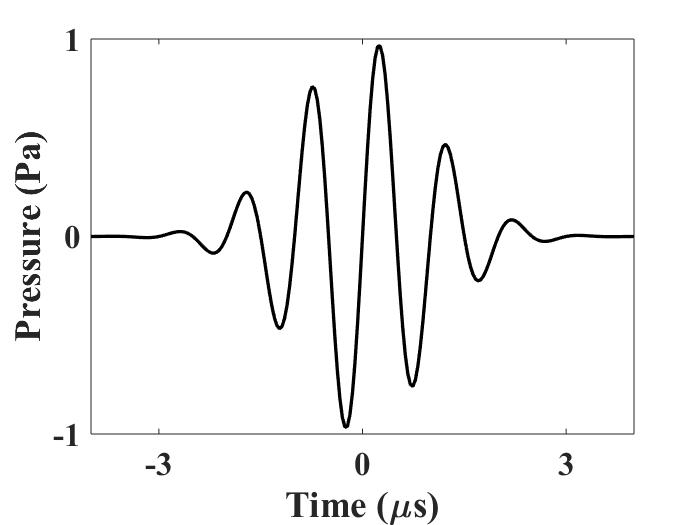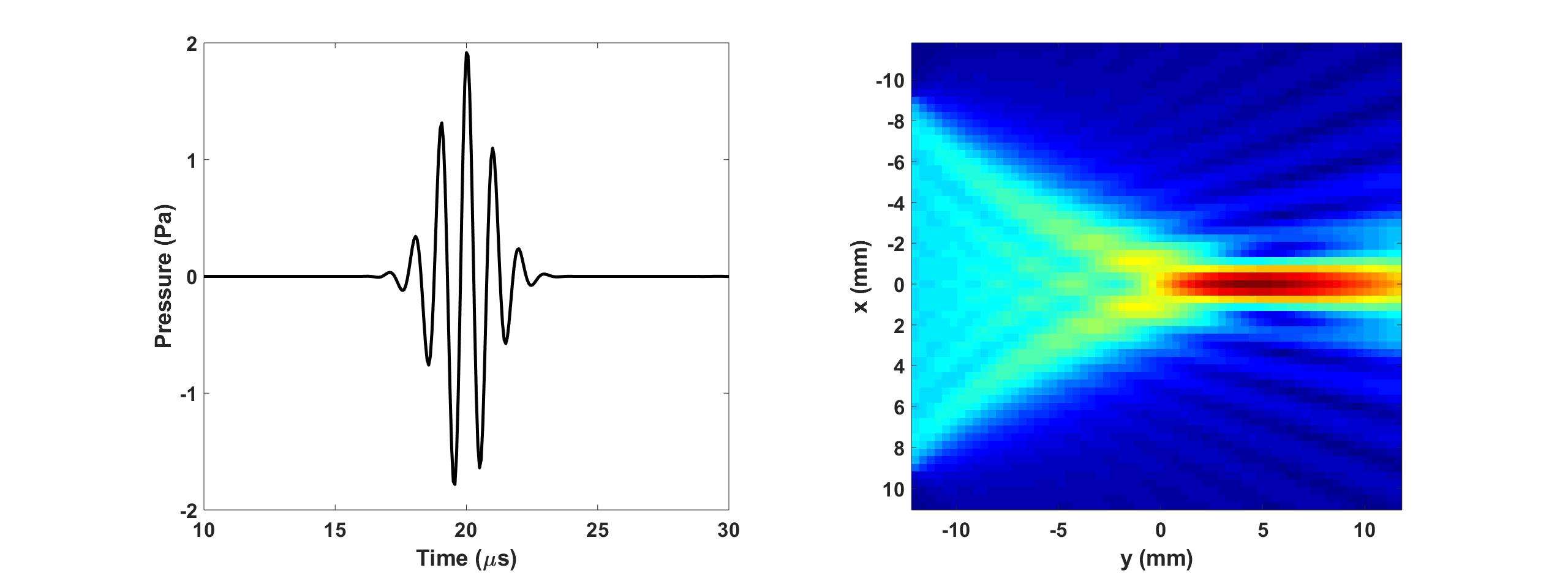Simulation of a 2D homogeneous medium using the transient mixed domain method
This example demonstrates how to simulate wave propagation in a 2D homogeneous medium using the transient mixed domain method. A focused beam is simulated.
Generating the grid structure to define the computational domain
We first need to define the temporal and spatial domains in 2D forward simulations with the function
set_grid. For 2D problems,
six inputs are required to call this function. Coordinates defined within the mgrid structure are all in the Cartesian coordinates.
In mSOUND simulations, the spatial resolution (dx for 2D; dx and dy for 3D) and the marching step size (dy for 2D; dz for 3D)
should in principle be a small fraction of the wavelength (e.g., 1/4 of the smallest wavelength) for stability and accuracy,
and it is common to have a marching step size different from the spatial resolution. One exception is that for homogeneous and linear media,
the step size can be arbitrarily large. The temporal resolution should at least satisfy the Nyquist criteria. In practice,
the best course of action is to have a convergence study conducted to determine the proper step size, spatial and temporal resolutions.
dx = 3.75e-04; % step size in the x direction [m]
dy = 3.75e-04; % step size in the y direction [m]
dt = 6.25e-08; % time step size [s]
x_length = 0.0454; % computational domain size in the x direction [m]
y_length = 0.0240; % computational domain size in the y direction [m]
t_length = 6e-05; % temporal domain size [s]
mgrid = set_grid(dt, t_length, dx, x_length, dy, y_length);
Defining the phased array transducer
In this example, a phased array transducer is used to generate the focused ultrasound beam.
fc = 1.0e6; % fundamental frequency [Hz]
TR_focus = 0.0180; % transducer focal length [m]
TR_radius = 0.0090; % transducer aperture radius [m]
% calculate the phase delay
delay = sqrt((mgrid.x).^2 + TR_focus^2)/medium.c0;
delay = delay - min(delay);
Excitation signal
A four-cycle Gaussian-modulated pulse is used for the excitation signal. The pulse is illustrated in the figure below.
ts = [-4/fc:dt:4/fc].'; % define the pulse length [s]
delay = repmat(delay, length(ts), 1);
ts = repmat(ts, 1, mgrid.num_x);
% define the excitation pulse
p0 = 1;
source_p = p0*sin(2*pi*fc*(ts+delay)).*exp(-(ts+delay).^2*fc^2/2);
source_p(:, abs(mgrid.x)>TR_radius) = 0;

Defining the medium properties
Define the homogeneous medium. For 2D simulations, the medium properties should be given as matrices with a size (mgrid.num_x, mgrid.num_y+1). For homogeneous media, though, the medium properties can be described by a single scalar. medium.c0 is the reference speed of sound and generally, it is chosen as the minimum value of medium.c. When the power law exponent is 2.0(thermo-viscous losses), dispersion becomes absent.
medium.c = 1500; % speed of sound [m/s]
medium.rho = 1000; % density [kg/m^3]
medium.beta = 0; % nonlinearity coefficient
medium.ca = 0; % attenuation coefficient [dB/(MHz^y cm)]
medium.cb = 2.0; % power law exponent
% non-reflecting layer
medium.NRL_gamma = 0.5;
medium.NRL_alpha = 0.05;
2D forward simulation
The pressure field is calculated with the 2D forward simulation function Forward2D. The waveform recorded at the transducer focal point and the center frequency pressure field distribution are shown below.
% define where the pressure will be recorded
sensor_mask = zeros(mgrid.num_x, mgrid.num_y+1);
sensor_mask(30:90,2:end) = 1;
% 2D forward simulation
p = Forward2D(mgrid, medium, source_p, sensor_mask, 0, 'NRL');

Other examples
·
Simulation of a 2D homogeneous medium using the transient mixed domain method
·
Simulation of a 2D heterogeneous medium using the transient mixed domain method
·
Simulation of a strongly 2D heterogeneous medium using the transient mixed domain method
·
Simulation of a 3D homogeneous medium using the transient mixed domain method
·
Selecting the proper temporal domain size for the TMDM
·
Shock wave simulations with TMDM
·
Simulation of a 2D homogeneous medium using the frequency-specific mixed domain method
·
Simulation of a 2D heterogeneous medium using the frequency-specific mixed domain method
·
Simulation of a 3D homogeneous medium using the frequency-specific mixed domain method
·
Simulation of a 3D heterogeneous medium using the frequency-specific mixed domain method
·
Reducing the spatial aliasing error using the non-reflecting layer
·
Comparing pressure release and rigid boundary conditions
·
Image reconstruction using backward projection
·
Reconstruction of the source pressure distribution with FSMDM in a 3D homogeneous medium
·
Integrating mSOUND with k-Wave for transducers of arbitrary shape
·
Integrating mSOUND with FOCUS for transducers of arbitrary shape
·
Integrating mSOUND with k-Wave for thermal simulations
